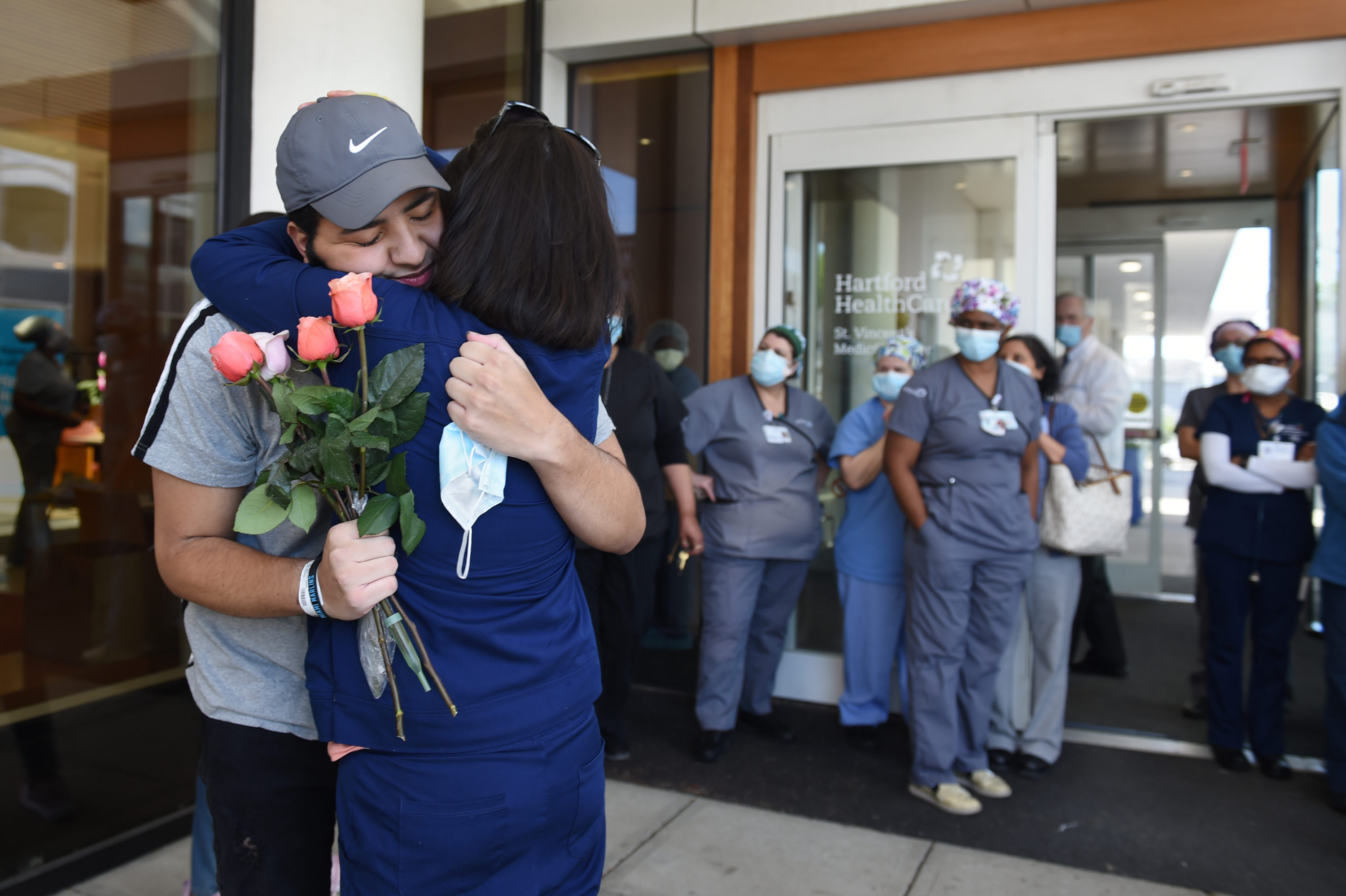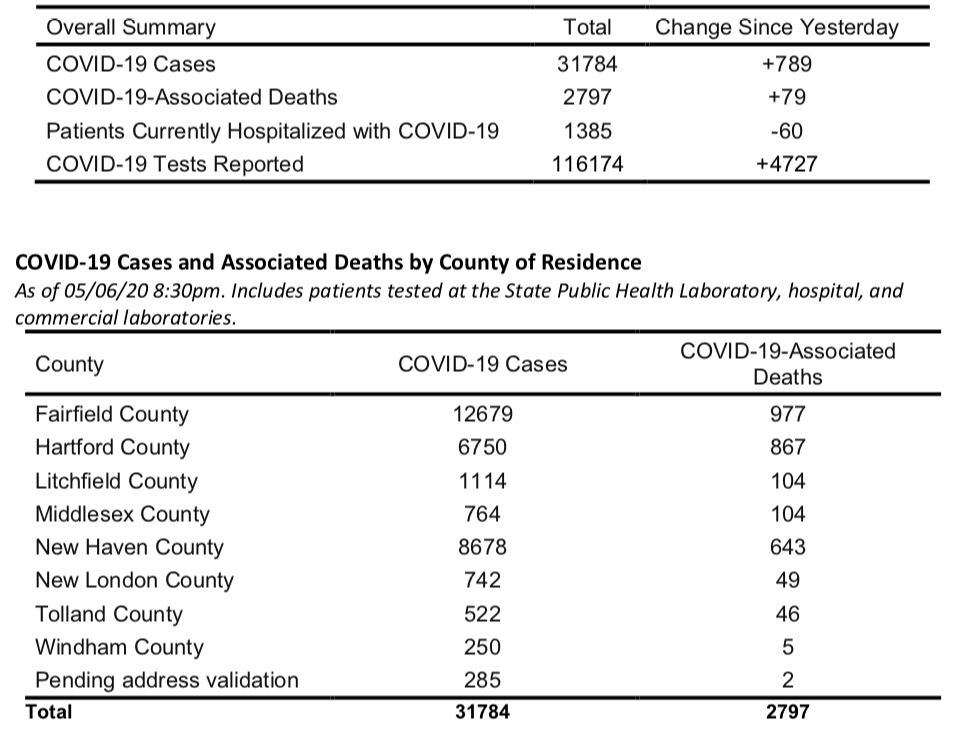Lamont Calls for More Testing as State Gets Closer to Reopening Some Businesses

Audio By Carbonatix

St. Vincent’s Medical Center’s first COVID-19 patient, Rodney Davis, 21, of Bridgeport, hugs nurse Jen Marrocco as he is released Thursday after recovering from the virus. Several health care workers from the hospital’s ICU took part in the sendoff. Davis was in a coma for one of the two months he spent there. “I feel much better,” he said. “I just want to go home.” Photo credit: Cloe Poisson, CTMirror.org
The state wants to run 42,000 COVID-19 tests a week and plans to test all nursing home residents and employees.
By Keith M. Phaneuf, Gregory B. Hladky, and Jenna Carlesso, CTMirror.org
West Hartford-specific information provided by Ronni Newton, We-Ha.com
As the state prepares to ease restrictions and allow some businesses to reopen later this month, officials want 42,000 COVID-19 tests to be processed each week – a significant increase in data collection that will include testing every single nursing home resident and employee in Connecticut, as well as other vulnerable populations.
The lack of pervasive testing remains a key hurdle to resuming many operations. The state on Thursday reported the results of 4,727 tests. A day earlier, it reported the results of only 2,804 tests – a one day spike that does not yet indicate a sustained increase in testing.

“We’ve ramped up our testing quite a bit,” Gov. Ned Lamont said. “But we want to get up to 42,000 diagnostic tests per week. That’s our goal over the next two weeks.”
Lamont said Connecticut so far has met some of the criteria required for certain businesses to reopen on May 20. He pointed to a 14-day decline in hospitalizations – figures reported Thursday show a 30% drop since the state’s peak – and to adequate capacity in the state’s hospitals.
But more work needs to be done in testing Connecticut’s most vulnerable people, he said, including those in nursing homes, people in “at-risk” urban communities, correctional facility staff and first responders. Appropriate workplace safeguards and sufficient capacity for contact tracing must also be arranged.
State officials have already begun testing all residents and staff in nursing homes, said Josh Geballe, Lamont’s chief operating officer. More than half of the state’s COVID-19 fatalities have involved nursing home residents.
“We have been constrained since the beginning of this pandemic by test kits and supplies, and more recently, we’ve started to get more supplies and we’ve been able to increase the amount of testing we’ve been doing,” Geballe said Thursday. “As recently as this past weekend, we’re now sending teams into our nursing homes to test everyone, whether they’re symptomatic or asymptomatic.”
The state is aiming to have a 30-day supply of personal protective gear – including masks, gloves, and gowns – on hand for its major health systems. Lamont said Thursday that the supply chain is stabilizing and that a sizable order of the equipment is expected to arrive on Saturday.
Data released Thursday show 79 new deaths were recorded, bringing the state’s total to 2,797. Hospitalizations dipped to 1,385, down by 60 from the figures published a day earlier.
Of the 4,727 test results reported, 17% – or 789 – came back positive.
In West Hartford, there was one more positive test reported Thursday, for a total of 353, and one. more fatality, bringing that total to 66.

Self-employed could receive jobless benefits in about one week
The state Labor Department launched the final phase Thursday of a new federal program to provide cash benefits to self-employed workers impacted by the coronavirus pandemic.
Some applicants could begin receiving benefits by direct deposit in just over a week
This component of the Pandemic Unemployment Assistance [PUA] went online in the morning, Labor Commissioner Kurt Westby said, adding it ultimately could provide up to $649 per week in benefits to more than 40,000 contractors, freelancers, and other self-employed individuals
“Due to the pandemic and the devastating effect it has had on many that are self-employed, for the first time ever, these individuals are facing workplace situations never seen before,” Westby said. “Unemployment benefits will help them weather such challenging times and help our economy recover faster.”
Self-employed individuals normally are ineligible for unemployment benefits because – unlike other employers – they do not pay into the system.
Those who apply for PUA benefits go through a two-stage process.
Initially they must apply for state unemployment benefits, after which they will receive a letter by traditional mail that restates – among other things – what they already know: that they’re ineligible for state benefits.
But it also will direct them to gather information on their 2019 earnings and then return to the state website at filectui.com. Self-employed workers affected by the pandemic then can complete their request for the federal PUA benefits.
PUA applicants will need to provide various 2019 federal tax forms and W-2 statements in the second phase of the application process. Those without tax records can self-attest to their earnings, but they will be subject to audit.
Applicants also will be asked in Phase Two to cite the date when COVID-19 impacted their employment.
State labor officials last week urged self-employed workers affected by the pandemic to begin the first phase of the application process, and that stage two of the application process would be online and ready by this week.
Officials had hoped to have it ready to go earlier this week, but Westby and Deputy Commissioner Dante Bartolomeo said it involved making even more programming modifications to the department’s 40-year-old IT system.
“I think we met our goal. We’re dealing with a 40-year-old system,” Westby said. “We have to do a lot of testing.”
More than 38,000 self-employed workers already have completed the first phase of the application process and the commissioner estimated more than 40,000 Connecticut individuals ultimately will receive PUA benefits.
Those who are approved may receive assistance for up to 39 weeks retroactive to Feb. 2.
Bartolomeo urged applicants for the PUA benefit to provide a savings or checking account number so that funds can be transferred via direct deposit.
Essential workers say they are denied benefits
Essential workers who’ve tested positive for COVID-19 throughout the state say they are being denied workers’ compensation benefits. Four women recovering from the virus spoke out during a press conference hosted by the Connecticut chapter of the AFL-CIO.
The state’s Workers’ Compensation Act does not consider contracting COVID-19 while on the job an occupational hazard, injury, or disease, according to the AFL-CIO. In April, the Lamont administration has said it would consider the gap but has not issued an executive order to date.
But Diane Logan says it’s hard to wait.
“We’re here, we’re working, we want to be taken care of. We want someone to take responsibility because I am positive that I did get the COVID from work,” said Logan, an outpatient staff nurse at UConn Health and member of University Health Professionals, AFT Local 3837.
Logan said she was paid for the first two weeks of work after testing positive in early April for coronavirus but has since then exhausted all of her sick time in the nearly three weeks that followed. According to Logan, nearly two dozen of the 100 employees at her clinic have tested positive for COVID-19.
Virginia Ligi is a corrections officer at Cheshire Correctional Institution. She said she and her coworkers started receiving cloth masks made by men incarcerated on-site after she tested positive for COVID-19 in March. She says she got “knocked off her feet” for three weeks.
“It was just the worst possible scenario in my head just because I have three young children at home,” Ligi said. “Being confined in my bed for nearly a month was so hard for me and my family.”
According to Ligi, the workers’ compensation claims she and others have submitted were denied by Gallagher Bassett, the insurance agency contracted by the Department of Correction.
“This pandemic is a threat to the health and well-being of all frontline workers everywhere, whether it’s a correction officer, store clerk, hospital nurse – we’re all doing our part to keep this world going and it’s so difficult that they keep denying us everything that we should get,” Ligi said.
Advocates want the Lamont administration to establish a presumption that will open up workers’ comp benefits to essential workers who’ve been working during the pandemic.
“Without the presumption, insurance companies are going to say, like they’re saying now, prove it – prove to us you didn’t get the virus somewhere else. That is not what we should be asking these essential workers to do,” said Eric Chester, an attorney who represents employees who’ve been denied benefits.
In early April, senate and house Democrats wrote letters to the Lamont administration in support of expanding worker’s compensation conditions to include on the job exposure for essential workers during the pandemic. They said asking essential workers to prove that they contracted the virus while at work would “create undue barriers for those working to provide essential services to Connecticut residents.”
“Given your ‘stay safe, stay home’ executive order many of these workers have no other exposure to the COVID-19 than on the job,” read the letter from Senate Democrats. “What these individuals have in common is the constant, daily exposure to strangers as part of their job.”
Hospitalizations dip
The number of hospitalized COVID-19 patients in Yale New Haven Health’s multi-hospital system has dropped from about 700 a week ago down to 600, officials said Thursday.
Marna Borgstrom, the system’s CEO, said at a video briefing that there are currently 360 coronavirus patients at Yale New Haven Hospital, 151 at Bridgeport Hospital, 54 at Greenwich Hospital, 27 at Lawrence & Memorial Hospital in New London, and one at Westerly Hospital in Rhode Island.
The system has conducted about 35,000 tests for the virus and that about 9,000 of those tests have come back positive for COVID-19.
Dr. Thomas Balcezak, chief clinical officer for Yale New Haven Health, said the system now has the capability of processing about 1,000 tests a day through its laboratories and officials hope to be expanding that to 3,000 lab tests per day by next week.
But shortages of testing kits and necessary supplies continue to be the most challenging and limiting factor in expanding coronavirus testing. Balcezak said the goal is to expand to 10,000 tests per day by June.
“We hope by August to be able to do 20,000 tests per day,” Borgstrom said, adding that the ultimate goal of Gov. Ned Lamont’s administration is to be able to conduct 50,000 tests a day across Connecticut.
“That is a very tall order,” she said. Reaching that goal will depend on consistent access to testing kits, supplies, staffing, and laboratory capacity.
Balcezak said Yale New Haven’s experience with COVID-19 is consistent with what’s happened at hospitals in Europe and China. He said about 80 percent of people who test positive experience mild symptoms, about 15 percent require hospitalization, and approximately 5 percent require intensive care and/or ventilation.
One unusual aspect of the disease, Balcezak said, is that about 50 percent of COVID-19 patients experience “extreme fatigue … that can last for weeks.” In the most severe cases, “The body’s ‘immune system starts attacking organs in the body,” he said.
“It’s really important to remember that we are not through with this,” Balcezak said.
Commenting on new projections concerning pandemic deaths in this state by mid-June, Balcezak said, “I wouldn’t be surprised to see 4,000 deaths in Connecticut” if current trends continue.
Hospitalizations in the Hartford Healthcare system also dropped gradually for the third day in a row this week, from 314 coronavirus patients on Tuesday, to 307 Wednesday, and to 304 Thursday.
“It’s a good sign,” Dr. Ajay Kumar, chief clinical officer for the Hartford Healthcare system, said this week of the slow decline in hospitalizations. He warned that there will be “some ups and downs” in the numbers during the weeks ahead and that Connecticut needs to go slow about easing social distancing and reopening the economy.
“We need to be very cautious at this time,” Kumar said, adding that a too-swift reopening of the state’s businesses could lead to a resurgence of the pandemic.
But Kumar said that, if most state controls over the economy and personal social distancing are continued, “I think we should be able to weather the storm at this time.”
Hartford Hospital continues to have the largest number of COVID-19 patients in the system with 139, followed by St. Vincent’s Medical Center with 74, and the Hospital of Central Connecticut with 48.
WNPR Reporter Ryan Lindsay contributed to this story.
Reprinted with permission of The Connecticut Mirror. The author can be reached at [email protected].
Like what you see here? Click here to subscribe to We-Ha’s newsletter so you’ll always be in the know about what’s happening in West Hartford! Click the blue button below to become a supporter of We-Ha.com and our efforts to continue producing quality journalism.



